5 | Point Atlas |
LU = Lung | Hand tai yin | |
LI = Large intestine | Hand yang ming | |
ST = Stomach | Foot yang ming | |
SP = Spleen | Foot tai yin | |
HT = Heart | Hand shao yin | |
SI = Small intestine | Hand tai yang | |
BL = Bladder | Foot tai yang | |
KI = Kidney | Foot shao yin | |
PC = Pericardium | Hand jue yin | |
GB = Gallbladder | Foot shao yang | |
LR = Liver | Foot jue yin | |
GV = Governing vessel | Du mai | |
CV = Conception vessel | Ren mai |
Extra points—points outside of the channels— new points—extraordinary points
When referring to the extra points, the proper name and the common Chinese location number are listed.
EX-HN | Head and neck | |
EX-CA | Chest and abdomen | |
EX-B | Back | |
EX-LE | Lower extremity | |
EX | “Breast point in front of the axilla” |

LU-7 Lie Que
(Broken Sequence)
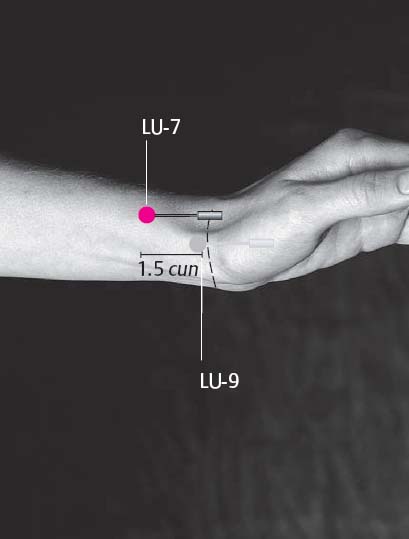

Direction of insertion: |
|
Depth of insertion: | 0.75–1.25 cm |
Phase: | Metal |
Location
On the radial side of the forearm, 1.5 cun proximally from the crease of the wrist on the channel pathway, above the radial artery.
Suggestion: Using the so-called “tiger’s mouth” makes it easier to find the point. The thumbs and index fingers of both hands are interlocked, which places the index finger of the right hand at the palpable radial styloid process with the radial artery below. The point lie que is located below the tip of the index finger.
Important Indications
• Blood pressure regulation
• Autonomic dysregulation
• Cough, asthma, and bronchitis
• Headache
• Sore throat and colds
• Local point: Pain in wrist and the metacarpophalangeal joint of the thumb
Traditional actions: Eliminates wind, cold, and other pathogenic factors, distributes the lung qi, and provides energetic balance with the coupled large intestine channel
Properties
Network point with the large intestine channel Confluence point for the ren mai channel European master point in cases of stasis
LU-9 Tai Yuan
(Great Abyss)
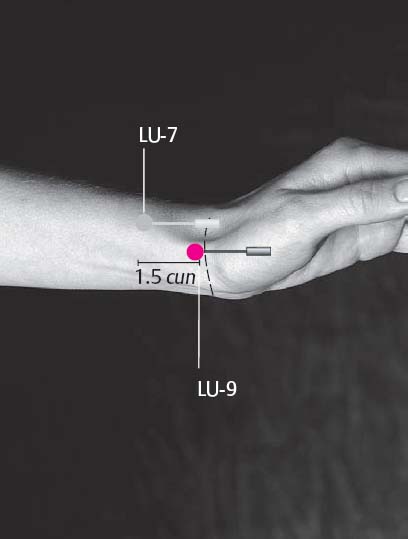

Direction of insertion: |
|
Depth of insertion: | 0.5–1.0 cm |
Phase: | Metal |
Location
On the radial side of the crease of the wrist, medial in the depression above the palpable radial artery. Suggestion: Visible pulsation of the needle indicates correct placement of the needle, close to the radial artery. At this needle location, stimulation techniques are to be avoided (no sedating technique with needle manipulation). If the radial artery is unintentionally punctured, apply firm compression; usually this is sufficient.
Important Indications
• Blood pressure regulation
• Circulatory disorders
• Disorders of the respiratory tract and the lungs (asthma, bronchitis, and cough)
• Pain in the arms
• Lymphostasis after breast surgeries
• Pain in the lateral part of the breast
Traditional actions: Disperses wind, balances phlegm production, alleviates cough, and calms ascending qi
Properties
Source point of the large intestine channel Traditional tonification point
Meeting point of the blood vessels
Suggestion: The direct vicinity of the radial artery is a desirable location for the tip of the needle because it has a direct effect on the perivascular sympathetic nerve plexus (effect on blood vessels, and blood pressure regulating effect!)
LI-4 He Gu
(Union Valley)
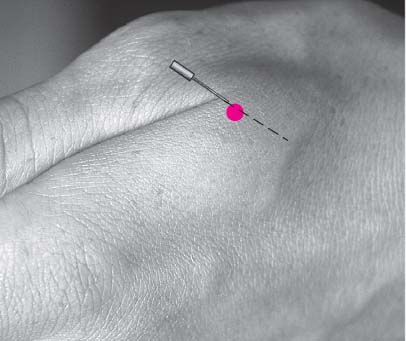

Direction of insertion: |
|
Depth of insertion: | 1.0–2.0 cm |
Phase: | Metal |
Location
There are three ways to locate this point:
1. Squeeze the thumb against the index finger; this causes the adductor muscle to bulge. The point is located from the end of the crease between thumb and index finger at a 90° angle to the most elevated point of the muscle. After the point has been located, the needle is inserted with the muscle in a relaxed position, and the direction of insertion is slightly oblique, as if entering the channel, in the direction of the second metacarpal bone.
2. With the thumb abducted, an imaginary diagonal line divides the angle between index finger and thumb. This line leads directly to the acupuncture point. Direction of insertion is the same as in 1. above.
3. With the thumb abducted, the crease of the inter-phalangeal joint of the other thumb is placed on top of the edge of the webbing between thumb and index finger. The tip of the thumb on top locates the point he gu. Direction of insertion is the same as in 1. above.
Important Indications
• The most important analgesic acupuncture point (when stimulated!) that treats the entire body; stimulates systemic endorphin secretion
• Allergic reactions, regulates the respiratory organs, nose, and lungs (bronchial asthma and allergic rhinitis)
• All abdominal complaints (including constipation, diarrhea, pain, colic, and digestion disorders)
• Labor-stimulating, labor-harmonizing, and birth-accelerating
• Regulating effect on severe postpartum contractions (particularly for multiparae)
• The most important general metabolism and elimination point
• Amenorrhea and hypomenorrhea
• Immunostimulation, fever, and inflammation
• Improves the mood
• Stimulates lactation
• Distal point for complaints in the area of the head (toothache, migraine, eyes, nose, and sinuses (coryza and sinusitis)
Traditional actions: Eliminates external pathogenic factors such as wind, cold, dampness, removes obstructions, and supports the flow of qi in the entire body
Frequently used, very energizing combination: LI-4 + LR-3
Properties
Source point
The analgesia, metabolism, elimination, and immunostimulation point
LI-10 Shou San Li
(Arm Three Li)
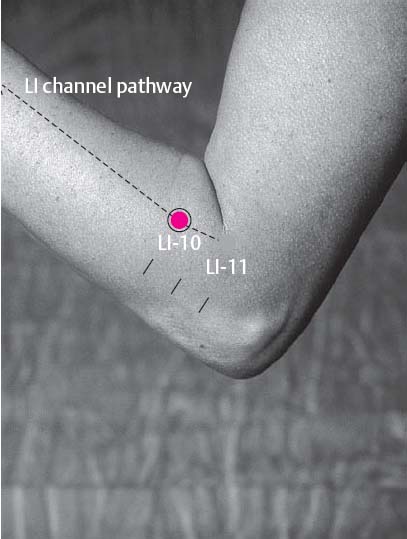

Direction of insertion: |
|
Depth of insertion: | 1.5–2.0 cm |
Phase: | Metal |
Location
On the forearm, two cun distal from LI-11 along the channel pathway, in the muscle body of the extensor muscles (extensor carpi, radialis longus, and supinator).
Important Indications
• Important auxiliary point with analgesic effects (used as the second point in electrostimulation)
• Important general tonification point
• Abdominal disorders (diarrhea, constipation, pain, and colic)
• Pain and limited mobility along the channel pathway.
LI-11 Qu Chi
(Pool at the Bend)
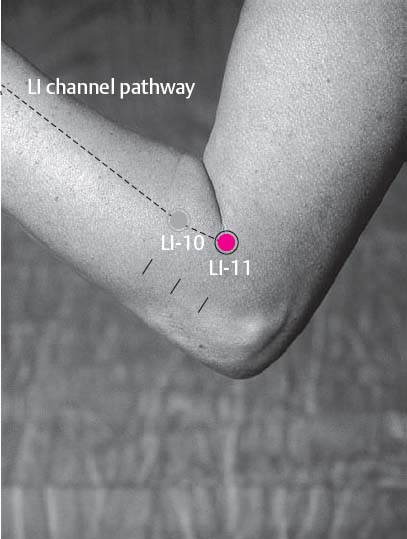

Direction of insertion: |
|
Depth of insertion: | 1.5–2.0 cm |
Phase: | Metal |
Location
With the forearm almost completely flexed, the point can be located right below the end of the elbow crease in a palpable depression that is sensitive to pressure. The location of the point qu chi is clearly medial to the lateral epicondyle of the humerus (epicondylus radialis humeri).
Suggestion: If there are multiple creases, pulling the skin slightly toward the lateral epicondyle reveals the main crease.
Important Indications
• Stimulates the immune system
• Effect on homeostasis
• Mastitis
• Relieves fevers
• Infections
• Itch (pruritis) and skin diseases (dermatitis)
• Allergic disorders
• Abdominal disorders (pain, colic, colitis, diarrhea, constipation, and indigestion)
• Local point: Disorders of the elbow, tennis elbow
• Channel pathway: Shoulder-arm syndrome.
Traditional actions: Eliminates wind, heat, dampness, lowers fever (regulates invasion of external pathogenic factors), and regulates and strengthens lung qi
Properties
He (ho) point of the large intestine Traditional tonification point
ST-15 Wu Yi
(Roof)
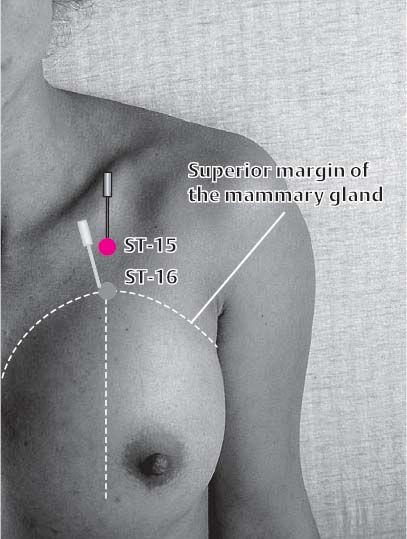

Direction of insertion: |
|
Depth of insertion: | 1.0 cm to not exceeding 1.5 cm |
Phase: | Earth |
Location
Four cun lateral from the midline (ren mai; midcl vicular line/mamillary line), second intercost space.
Point category: Potentially dangerous point (risk of puncturing the lung).
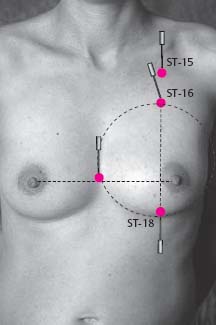
Important Indications
• Functional disorders of the breast (mastopathy, mastitis, lactation disorders, galactostasis, lack of milk, and breast pain)
• Generally ST-16 is used instead of ST-15. If the mammary gland is rather large, the upper margin of the gland is moved cranially, which requires the use of ST-15 instead of ST-16
ST-16 Ying Chuang
(Breast Window)
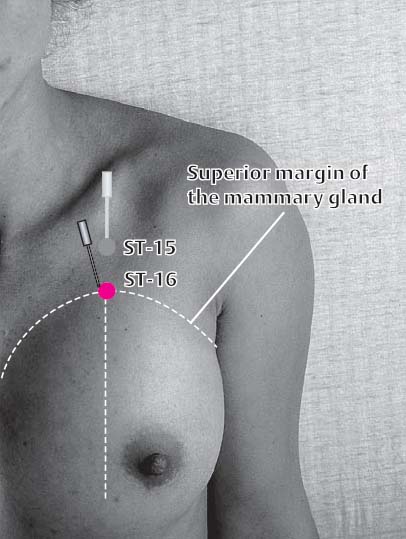

Direction of insertion: |
|
Depth of insertion: | 1.0 cm to not exceeding 1.5 cm |
Phase: | Earth |
Location
Four cun lateral from the midline, third intercost space, at the upper margin of the mammary gland Point category: Potentially dangerous point (risk of puncturing the lung).
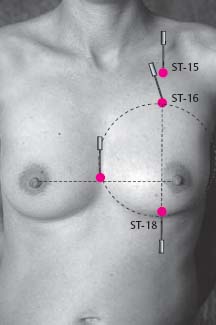
Important Indications
• Same as ST-15
ST-17 Ru Zhong
(Breast Center)
Contraindicated point to both needling and moxibustion.
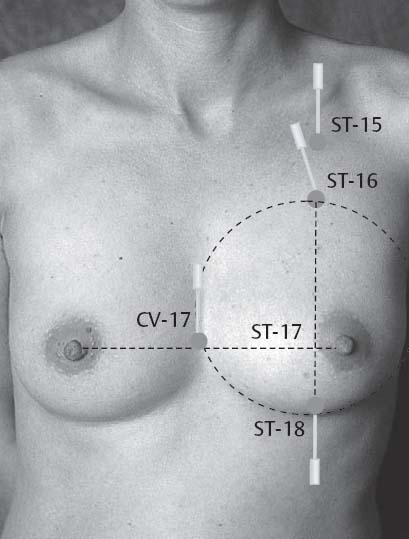

Location
At the nipple. Ideally, its anatomical location is at the fourth intercostal space, four cun lateral to the midline, at the level of CV-17.
Important Indications
• The point is only used as an anatomical reference.
ST-18 Ru Gen
(Breast Root)
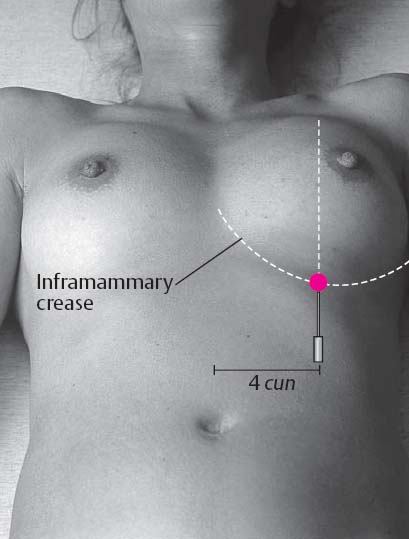

Direction of insertion: |
|
Depth of insertion: | 1.0 cm to not exceeding 1.5 cm |
Phase: | Earth |
Location
Four cun lateral from the midline, at the fifth intercostal space, inframammary crease, lower margin the mammary gland.
Point category: Potentially dangerous point (risk of puncturing the lung).
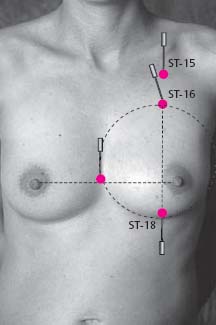
Important Indications
• Same as ST-15
ST-25 Tian Shu
(Celestial Pivot)
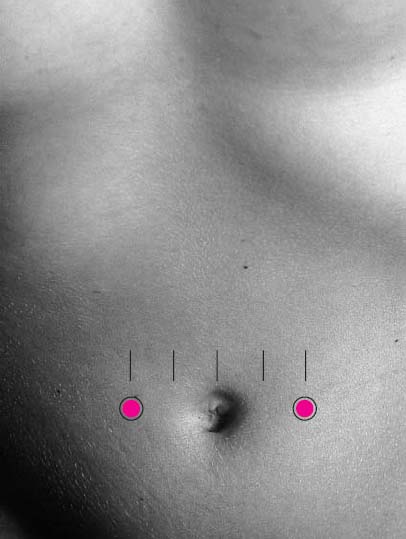

Direction of insertion: |
|
Depth of insertion: | 1.5–2.0 cm |
Phase: | Earth |
Location
Two cun lateral to the midline (ren mai), level with the navel (CV-8).
Important Indications
• Placental detachment and detachment disorders
• Uterine contraction coordination
• Functional gastrointestinal disorders (gastritis, ulcer)
• Crohn disease and ulcerative colitis
• Diarrhea
• Constipation
• Nausea
• Abdominal pain and cramps, meteorism winds
• Dysmenorrhea.
Traditional actions: Improves circulation of the stomach qi and strengthens the earth phase
Properties
Alarm point of the large intestine (diagnostic aid in the case of large intestine disorders)
ST-29 Gui Lai
(Return)
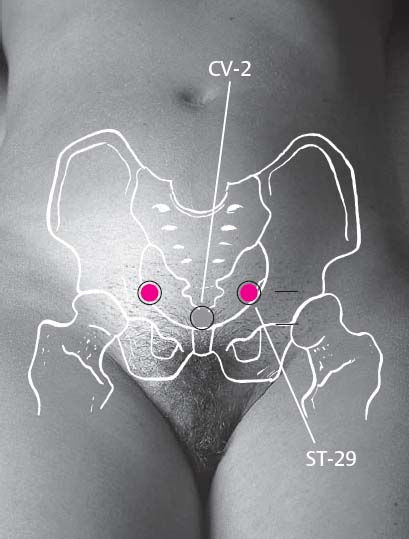

Direction of insertion: |
|
Depth of insertion: | 1.5–2.5 cm |
Phase: | Earth |
Location
Two cun lateral to the midline (ren mai), one cun superior to the pubic crest (at the level of the point CV-3).
Important Indications
• Retention of urine
• Constipation and diarrhea
• Urogenital disorders and inflammations
• Menstrual disorders, dysmenorrhea, amenorrhea, and fertility disorders
• Retained placenta.
Properties
Connective point to chong mai
ST-36 Zu San Li
(Leg Three Li)
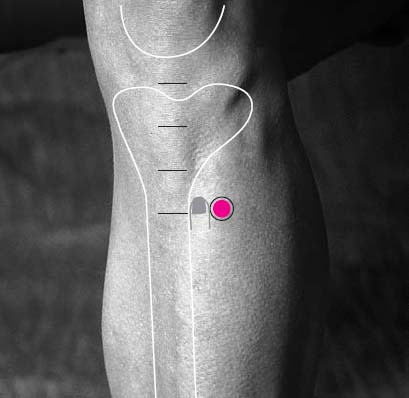

Direction of insertion: |
|
Depth of insertion: | 1.5–2.5 cm |
Phase: | Earth |
Location
1. ST-37 lies one cun inferior to GB-34 and one fingerbreadth lateral to the anterior crest of the tibia. Locate a pressure-sensitive depression on the tibialis anterior muscle.
2. Standing: Three cun inferior to the apex of the patella, one cun lateral to the tibia.
3. Sitting: Four cun inferior to the apex of the patella, one cun lateral to the tibia.
Important Indications
• Generally a powerful point
• Analgesic and spasmolytic effects
• Birth preparation and facilitation of childbirth
• Mentally/emotionally balancing
• Blood pressure regulation, vertigo, and weakness conditions
• Effect on hormones
• Effect on homeostasis
• Metabolism and elimination point, mastitis, and skin disorders
• Distal point with effect on the urogenital area and functional abdominal disorders (indigestion, pain, diarrhea, constipation, nausea, vomiting, and meteorism)
• Headache and migraine
• Edema, pain, spasm, and paresis of the lower extremities.
Traditional actions: Tonification in vacuity conditions, regulates qi and blood, balances the function of stomach and spleen, expels moisture, disperses dampness, tonifies the kidneys, stops vomiting, and wards off external pathogenic factors
Frequently used basic combination:
• ST-36 + SP-6 + CV-6
In the case of nausea and vomiting:
• ST-36 + CV-12
Generally strong tonifying effect, regulates menstruation and hormones, menstruation disorders, dysmenorrhea, fertility disorders, birth preparation, and facilitation of childbirth in the case of protracted delivery (cervical dystocia)
Properties
He (ho) point of the stomach
European master point for hormones and blood pressure (blood pressure balance)
General tonification point
ST-44 Nei Ting
(Inner Court)
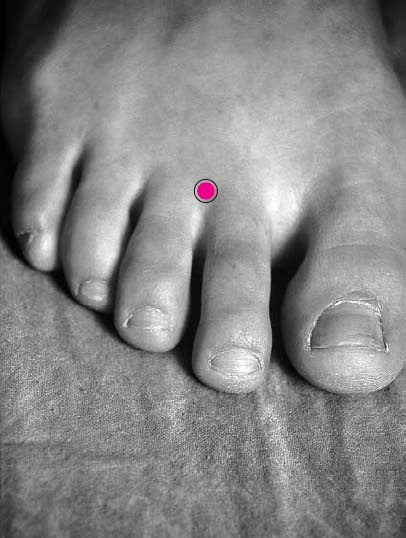

Direction of insertion: |
|
Depth of insertion: | 0.5–1.25 cm |
Phase: | Earth |
Location
Directly (0.5 cum) above the margin of the web, in a depression between the second and third toe.
Important Indications
• Analgesia point (stimulation/electrostimulation)
• Burning stomach and abdominal pain (heartburn, ulcer, and gastritis)
• Fever
• Increases peristalsis
• Distal point for frontal headache and migraine
• Stasis, pain, and fever when breastfeeding.
Traditional actions: Cools heat in the channel and the stomach, and regulates qi
Properties
Analgesic point
SP-4 Gong Sun
(Yellow Emperor)
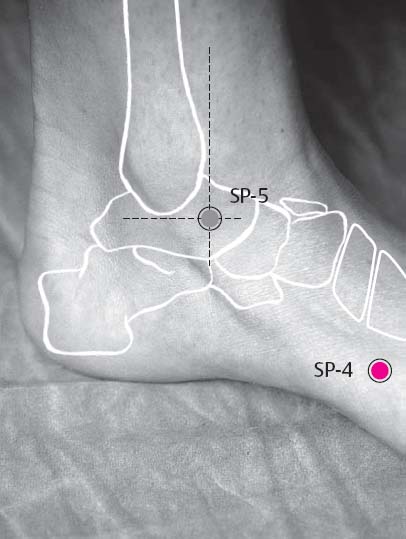

Direction of insertion: |
|
Depth of insertion: | 1.0–2.0 cm |
Phase: | Earth |
Location
On the medial side of the foot, in a palpable depression distal to the base of the first metatarsal bone, where the skin of the top of the foot meets the skin of the bottom of the foot (change from red to white skin color).
Important Indications
• Used in an attempt to induce menstrual flow in the case of amenorrhea
• Menstrual disorders and dysmenorrhea
• Fertility disorders
• European master point for diarrhea
• Edema
• Upper abdomen and digestion disorders (nausea, vomiting, pain, spasm, pancreatic insufficiency, and meteorism).
Traditional actions: Regulates the “Sea of Blood” (initiation of menstrual flow), regulates the chong mai channel, regulates menstruation, and regulates and strengthens stomach and spleen
Properties
Network point for the stomach channel
Confluence point for the chong mai channel
European master point for diarrhea
SP-5 Shang Qiu
(Shang Hill)
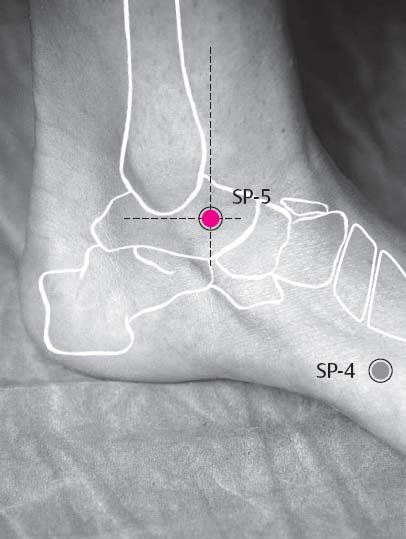

Direction of insertion: |
|
Depth of insertion: | 0.5–1.0 cm |
Phase: | Earth |
Location
In the depression at the intersection of the imaginary horizontal line inferior to the medial malleolus and the imaginary vertical line anterior to the medial malleolus.
Important Indications
• General swelling and edema (similar to LU-7)
• Edema in the area of the calf and malleolus
• Effect on connective tissue, varicosity and hemorrhoids
• Disorders of the upper and middle abdomen (gastritis, diarrhea, constipation, and indigestion)
• Local point: Ankle joint complaints.
Properties
Traditional sedation point
European master point for connective tissue
SP-6 San Yin Jiao
(Three Yin Intersection)
Cardinal point for all obstetric/gynecological indications
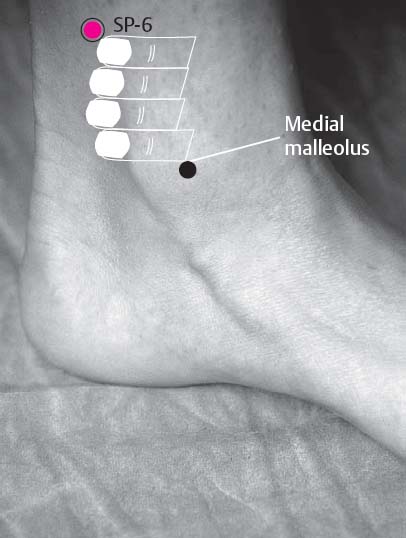

Direction of insertion: |
|
Depth of insertion: | 1.5–2.5 cm |
Phase: | Earth |
Location
At the medial side of the lower leg, four cun (four finger-breadths) superior to the tip of the medial malleolus, in a palpable and pressure-sensitive depression posterior to the tibia. The point is not located directly next to the tibia but dorsally, on the body of the muscles on the horizontal line toward the Achilles tendon.
Suggestion: The point SP-6 is well suited to being used for practicing pressure sensitivity and palpability of acupuncture points. Pressure sensitivity changes in the course of the menstrual cycle. For most women, SP-6 is considerably more pressure-sensitive during the second half of the cycle than during the first half. Patients with cycle or fertility disorders experience less sensitivity to pressure at this point.
Important Indications
• The most important obstetric/gynecological point (cardinal point) for all functional disorders
• Hormonal and fertility disorders, menopausal disorders
• All urological disorders (dysuria, increased urgency to urinate, residual urine, urinary retention, and cystitis)
• All gynecological disorders (amenorrhea, dysmenorrhea, irregular menstruation, and irregular bleeding of the uterus, also postpartum), vaginal discharge, nonspecific pain in the area of the genitals, reproductive organs, and pelvis
• Important analgesic point for minor surgeries in the areas of the lower extremities, the lower pelvis, and the external genitals
• Allergic and immunological disorders, skin disorders
• Edema
• Birth preparation and facilitation of childbirth
• The most important point for protracted delivery due to cervical dystocia (combined with ST-36—imbalance of the earth phase)
• Regulates labor
• Stimulates blood circulation in the lower pelvis
• Included in the overall strengthening combination: ST-36 + SP-6 + CV-6
• Gastrointestinal disorders
• General tonification point (in the case of vacuity or weakness conditions, vacuity-type sterility [moxibustion!], convalescence, chronic fatigue, insomnia, and hypotension)
• Blood pressure regulation
• Regulation of functional disorders of the kidneys, liver, and spleen/pancreas
• Circulatory disorders, edema, spasms, phlebitis, lymphangitis, and pain in the area of the lower extremities.
Traditional actions: Regulates and strengthens the spleen, pancreas, and stomach, strengthens the yin, removes stasis and obstruction of qi and blood, supports their balanced flow, eliminates dampness, tonifies the kidneys, regulates menstruation, and regulates imbalanced sexual functions
Frequently used basic combinations:
• Psychosomatic disorders
SP-6 + HT-7
• Disorders of the urogenital tract
SP-6 + CV-4
• To tonify the kidneys, regulate blood flow
SP-6 + KI-3
• To regulate urination and disorders of the urogenital tract
SP-6 + CV-3.
Suggestion: The three yin channels come very close to each other in the area of SP-6, KI-8, and LR-5. The exact anatomical position of KI-8 is slightly inferior and posterior to SP-6, and LR-5 is superior and anterior to SP-6.
Properties
Cardinal point for all obstetric and gynecological disorders
Note: Contrary to warnings which appear in the literature, this point ist not contraindicated for needling during a normal pregnancy.
SP-9 Yin Ling Quan
(Yin Mound Spring)
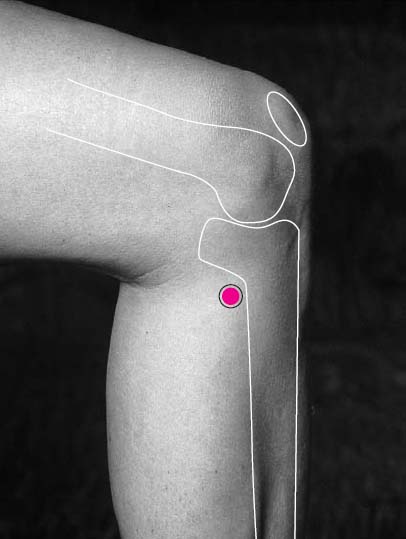

Direction of insertion: |
|
Depth of insertion: | 1.5–2.5 cm |
Phase: | Earth |
Location
On the medial side of the lower leg with the knee flexed, in a depression inferior to the medial tibial condyle where the shaft of the tibia begins. The point GB-34 is located at the same level on the lateral side.
Important Indications
• Edema (diuretic point) and swelling of the lower extremities
• All urogenital disorders, menstrual disorders, and gynecological disorders
• Pain in the external genital area
• Diarrhea, constipation, pain, and indigestion (abdominal spasms)
Local point: Pain in the knee joints
• Effect on the pancreas (indigestion)
Traditional actions: Eliminates dampness very effectively, removes heat, regulates the urinary tract collection system, and promotes urination.
Properties
He (ho) point of the spleen and the pancreas Important point for edema and elimination
HT-3 Shao Hai
(Lesser Sea)
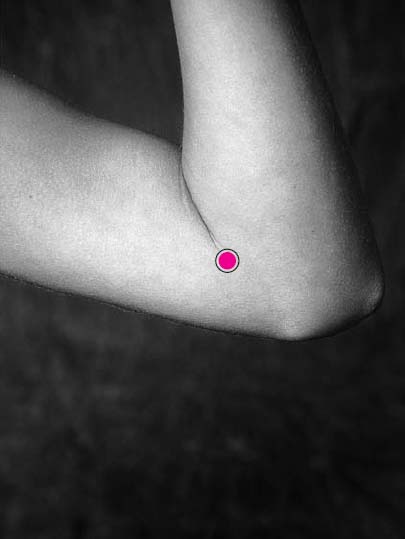

Direction of insertion: |
|
Depth of insertion: | 1.5–2.0 cm |
Phase: | Fire |
Location
With the elbow almost completely flexed, locate the point at the medical end of transverse crease, in a depression anterior to the medial epicondyle of the humerus, a change in pressure sensitivity can be observed.
Important Indications
• Balances psychoautonomic dysregulation, anxiety and tension conditions, and calms and lifts the spirit in cases of depression
Suggestion: Use the so-called heart axis, including HT-3 and HT-7
• Local point (tennis elbow and epicondylitis)
• Effect on thorax, axilla, and mamma
• Functional cardiac disorders
Properties
He (ho) point of the heart
HT-7 Shen Men
(Spirit Gate)
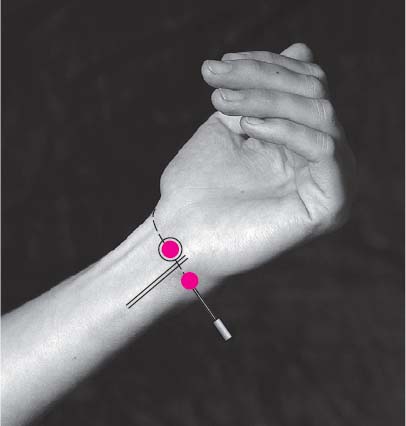

Direction of insertion: |
|
Depth of insertion: | 0.5–1.0 cm |
Phase: | Fire |
Location
On the crease of the wrist, medial to the palpable tendon of the flexor carpi ulnaris, in a depression at the end of the wrist crease (between the pisiform and the ulna). The direction of needle insertion is perpendicular to the skin and parallel to the wrist crease, beneath the tendon.
Suggestion: In some textbooks, the location of the point HT-7 is listed as lateral to the tendon of the flexor carpi ulnaris. If the direction of insertion is at a 90° angle to the skin, the tip of the needle ends up at the same location as the needle that is inserted from the side of the wrist. In practice, the acupuncture approach from the side of the wrist has proven to be more effective. Therefore, details about additional ways to locate HT-7 are omitted.
Important Indications
• Important mentally/emotionally balancing point that “stimulates and calms the spirit.” The basic mentally/emotionally balancing combination: HT-7 + PC-6 + GV-20
(if only points of the HT channel are used, the so-called heart axis including HT-3 and HT-7 is frequently used)
• Regulates functional cardiac disorders, cardiac dysrhythmias (palpitations), circulatory dysregulation, and angina pectoris
• Psychosomatic disorders
• Withdrawal symptoms in addictions
• Balances energy in anxiety, restlessness, and agitated conditions, insomnia, irritability, and depression
• Heat of the palms Effect on the shen (spirit).
Properties
Source point
Traditional sedation point
SI-3 Hou Xi
(Back Ravine)
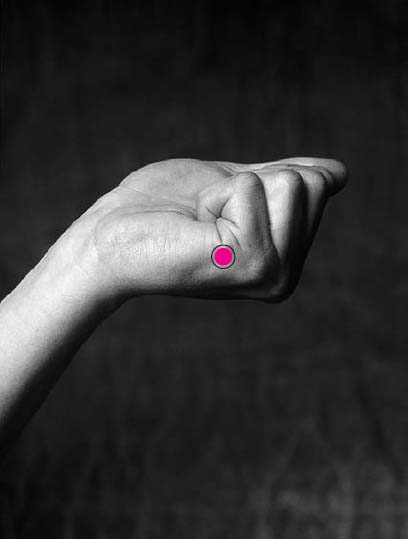

Direction of insertion: |
|
Depth of insertion: | 0.5–1.5 cm |
Phase: | Fire |
Location
At the medial end of the crease that is created when making a fist (transverse crease), where the color of the skin turns from white to pink (palpable change from the shaft to the distal epiphysis of the fifth metacarpal bone).
Important Indications
• Relieves spasm (similar effect as LR-3)
• Lactation disorders and mastitis
• Effect on all mucous membranes
• Fever and night sweat
• Indigestion
• Distal point for pain and stiffness in the areas of the neck, shoulder, cervical, and lumbar spine syndrome, sciatica, and intercostal neuralgia (through the connection to the du mai channel)
• Headache (temporal)
• Earache, tinnitus, and acute hearing loss
• Corresponding channel to the bladder channel
(back pain, lumbago, etc.)
Properties
Confluence point for the du mai channel
Traditional tonification point
BL-2 Zan Zhu
(Bamboo Gathering)
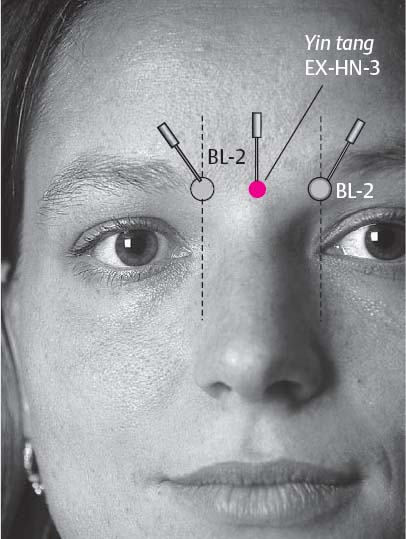
Stay updated, free articles. Join our Telegram channel

Full access? Get Clinical Tree







 in the direction of the anatomical position of the nipple
in the direction of the anatomical position of the nipple in the direction of the anatomical position of the nipple
in the direction of the anatomical position of the nipple in the direction of the anatomical position of the nipple
in the direction of the anatomical position of the nipple










